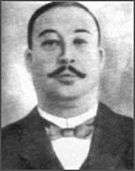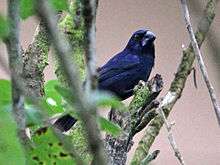Chôros No. 10
| Chôros No. 10 | |
|---|---|
| "Rasga o Coração" | |
| by Heitor Villa-Lobos | |
.jpg) Heitor Villa-Lobos | |
| English | It Rends the Heart (subtitle) |
| Key | Polytonal |
| Catalogue | W209 |
| Genre | Chôros |
| Form | Chôros |
| Text | "Rasga o Coração" (Catulo da Paixão Cearense) |
| Language | Portuguese |
| Melody | Birdsong (azulão da mata); "Yará" (Anacleito de Medeiros) |
| Composed | 1926: Rio de Janeiro |
| Dedication | Paulo Prado |
| Published | 1928: Paris; second edition: 1975: Paris |
| Publisher | Max Eschig |
| Recorded | November 30, 1949 Werner Janssen, Janssen Symphony Orchestra, Los Angeles Oratorio Society (10-inch monaural LP, Capitol Classics L 8 043) |
| Duration | 13 mins. |
| Movements | 1 |
| Scoring | Large orchestra and mixed choir |
| Premiere | |
| Date | 11 November 1926 |
| Location | Teatro Lírico, Rio de Janeiro |
| Conductor | Heitor Villa-Lobos |
| Performers | Grande Orquestra da Empresa Viggiani; Coro de artistas brasileiros; Deutscher Männerchor |
Chôros No. 10 ("Rasga o Coração") is a work for chorus and orchestra written in 1926 by the Brazilian composer Heitor Villa-Lobos. It is part of a series of fourteen numbered compositions collectively titled Chôros, ranging from solos for guitar and for piano up to works scored for soloist or chorus with orchestra or multiple orchestras, and in duration up to over an hour. Chôros No. 10 is of moderate length, one performance recorded by the composer lasting just under thirteen minutes.
History


Chôros No. 10 was composed in Rio de Janeiro in 1926, and the score is dedicated to Paulo Prado. It was premiered in a concert presented in homage to the President of Brazil, Washington Luís, on 11 November 1926 at the Teatro Lírico in Rio de Janeiro by the Grande Orquestra da Empresa Viggiani, the Coro de artistas brasileiros, and the Deutscher Männerchor, conducted by the composer. This was also Villa-Lobos's farewell performance to Rio de Janeiro. The programme contained an announcement of his imminent departure for Europe. The European premiere took place in Paris on 3 December 1927 at the Salle Gaveau with the Orchestre des Concerts Colonne and L'Art Choral, once again with the composer conducting. The American premiere was given by the Philharmonic-Symphony Orchestra of NewYork and the Schola Cantorum, conducted by Hugh Ross, on 15 January 1930, at Carnegie Hall in New York (Villa-Lobos, sua obra 2009, 25; Magaldi 2006, 219).
Already within the composer's lifetime the work became the best-known of all the Chôros (Appleby 2002, 87). In the second half of the work, Villa-Lobos introduces a popular melody, originally a schottische called Yará, written by Anacleto de Medeiros. In a slower tempo, sung to a poem written by Villa-Lobos's friend and former fellow chorão, Catulo da Paixão Cearense, it had become a popular song, "Rasga o coração" (Rend the Heart). It was in this form that Villa-Lobos used both the melody and the words, and he used the song's title as a subtitle for the Chôros, together with an acknowlegdement, "D'après la poésie de Catullo Cearence" [sic]. The poet attended the 1926 premiere of Chôros No. 10 in the Teatro Lírico, and was overcome with emotion, embracing the composer in a gesture of gratitude (Wright 1992, 72). Unfortunately, in a moment of financial distress, Catulo had sold the rights of all his literary works to a man named Guimarães Martins, who evidently remained ignorant of Villa-Lobos's use of the text for nearly thirty years until by chance, at a demonstration of new gramophone players at the Ministry of Education in Rio de Janeiro, a recording of the work was used as an example. Martins initiated a breach of copyright action against Villa-Lobos, which was finally resolved only in 1956—in the composer's favour. Nevertheless, the performance of the work Villa-Lobos recorded in Paris in May 1957 substituted neutral syllables for Catulo's text, and when the publisher Max Eschig reissued the score in 1975, the text was likewise removed. Most performances since then, however, have restored the words of Catulo's poem (Appleby 2002, 87; Wright 1992, 72)
Analysis

Chôros No. 10 falls into two main sections, the first for orchestra alone, the second adding a mixed choir. The question of the further subdivision of part one is less certain. It can be regarded as falling into two subdivisions: a rhythmically energetic impetus (page numbers 1–18) and an impressionistic noctume, with the tempo marking Lent (page numbers 18–35) (Tarasti 1995, 123–24).
The composer describes Amazonian birdsong as an important source of motivic material in the opening portion of Chôros No.10. The first thematic fragment, presented in the flute in bar 3, is "a transfigured melodic cell characteristic of the song of a rare bird of the Brazilian forests, called in some places Azulão da mata"—in English called blue-black grosbeak (Villa-Lobos 1972, 204).
References
- Antokoletz, Elliott. 1992. Twentieth-Century Music. Englewood Cliffs, N.J.: Prentice-Hall.
- Appleby, David P. 2002. Heitor Villa-Lobos: A Life (1887–1959). Lanham, MD, and London: Scarecrow Press. ISBN 0-8108-4149-5.
- Béhague, Gerard. 1994. Villa-Lobos: The Search for Brazil's Musical Soul. Austin: Institute of Latin American Studies, University of Texas at Austin, 1994. ISBN 0-292-70823-8.
- Magaldi, Cristina. 2006. "Two Musical Representations of Brazil: Carlos Gomes and Villa Lobos". In Brazil in the Making: Facets of National Identity, edited by Carmen Nava and Ludwig Lauerhass Jr., 205–228. Lanham: Rowman & Littlefield Publishers, Inc. ISBN 978-0-7425-3756-9 (cloth); ISBN 978-0-7425-3757-6 (pbk).
- Moreira, Gabriel Ferrão. 2012. "Diatonismo, Pentatonismo, Octatonismo e suas interações no Choros no10 de Heitor Villa-Lobos: Em busca de uma percepção idiossincrática de modernidade musical". Anais do II Simpósio Villa-Lobos: Perspectivas Analíticas para a Música de Villa-Lobos, São Paulo, 23 a 25 de novembro de 2012, edited by Paulo de Tarso Salles and Ísis Biazioli de Oliveira, 289–304. São Paulo: Departamento de Música/Escola de Comunicações e Artes/Universidade de São Paulo. ISBN 9788572050982.
- Moreira, Gabriel Ferrão. 2014. "A construção da sonoridade modernista de Heitor Villa-Lobos por meio de processos harmônicos: um estudo sobre os Choros". PhD diss. São Paulo: Universidade do Estado de São Paulo.
- Negwer, Manuel. 2008. Villa-Lobos: Der Aufbruch der brasilianischen Musik. Mainz: Schott Music. ISBN 3-7957-0168-6. Portuguese version as Villa Lobos e o florescimento da música brasileira. São Paulo: Martins Fontes, 2009. ISBN 978-85-61635-40-4.
- Peppercorn, Lisa M. 1991. Villa-Lobos: The Music: An Analysis of His Style, translated by Stefan de Haan. London: Kahn & Averill; White Plains, NY: Pro/Am Music Resources Inc. ISBN 1-871082-15-3 (Kahn & Averill); ISBN 0-912483-36-9.
- Seixas, Guilherme Bernstein. 2007. "Procedimentos Composicionais nos Choros Orquestrais de Heitor Villa-Lobos". PhD diss. Rio de Janeiro: Universidade Federal do Estado de Rio de Janeiro.
- Tarasti, Eero. 1995. Heitor Villa-Lobos: The Life and Works, 1887–1959, translated from the Finnish by the author. Jefferson, NC, and London: McFarland & Company, Inc., Publishers. ISBN 0-7864-0013-7.
- Tygel, Júlia Zanlorenzi. 2012. "O uso composicional do tema indígena Pareci no segundo movimento do Choros No. 10 de Villa-Lobos". Anais do II Simpósio Villa-Lobos: Perspectivas Analíticas para a Música deVilla-Lobos, São Paulo, 23 a 25 de novembro de 2012, edited by Paulo de Tarso Salles and Ísis Biazioli de Oliveira, 305–18. São Paulo: Departamento de Música/Escola de Comunicações e Artes/Universidade de São Paulo. ISBN 9788572050982.
- Villa-Lobos, Heitor. 1972. "Choros: Estudo técnico, estético e psicológico", edited in 1950 by Adhemar Nóbrega. In Villa-Lobos, sua obra, second edition, 198–210. Rio de Janeiro: MEC/DAC/Museu Villa-Lobos.
- Villa-Lobos, sua obra. 2009. Version 1.0. MinC / IBRAM, and the Museu Villa-Lobos. Based on the third edition, 1989.
- Wright, Simon. 1992. Villa-Lobos. Oxford Studies of Composers. Oxford and New York: Oxford University Press. ISBN 0-19-315476-5 (cloth); ISBN 0-19-315475-7 (pbk).
Further reading
- Bordini, Ricardo Mazzini. 2006. "Heitor Villa-Lobos, Choros (No. 10), 'Rasga o Coração' ou 'Jurupari': coletânea de citações e uma discussão dos aspectos motívicos e formais da obra". Ictus: Periódico do Programa de Pós-Graduação em Música da UFBA, 7:87–94.
- Neves, José Maria. 1977. Villa-Lobos, o choro e os choros. São Paulo: Musicália S.A.
- Nóbrega, Adhemar Alves da. 1975. Os chôros de Villa-Lobos. Rio de Janeiro: Museu Villa-Lobos.
- Peppercorn, Lisa M. 1980. "A Villa-Lobos Autograph Letter at the Bibliothèque Nationale (Paris)". Latin American Music Review / Revista de Música Latinoamericana 1, no. 2 (Autumn–Winter): 253–64.
- Salles, Paulo de Tarso. 2009. Villa-Lobos: processos composicionais. Campinas, SP: Editora da Unicamp. ISBN 978-85-268-0853-9.
External links
- villalobos.iu.edu Villa-Lobos site at Indiana University: Maintained by the Latin American Music Center